IEA: Oil Market Near Balance But US Production Could Rise Again 04/15/17 •lweb.es/f2772 •bit.ly/2oO1aQs
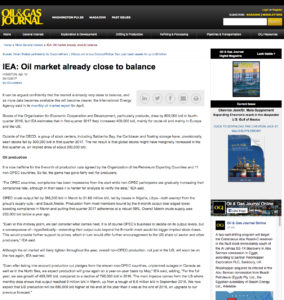 Now is the halfway point for the 6-month oil production cuts agreed by OPEC and the 11 other oil producing countries, and the market is very close to balance. The International Energy Agency has observed that “Even at this midway point, we can consider what comes next … extending their output cuts beyond the 6-month mark would be bigger implied stock draws. This would provide further support to prices, which in turn would offer further encouragement to the US shale oil sector and other producers.”
Now is the halfway point for the 6-month oil production cuts agreed by OPEC and the 11 other oil producing countries, and the market is very close to balance. The International Energy Agency has observed that “Even at this midway point, we can consider what comes next … extending their output cuts beyond the 6-month mark would be bigger implied stock draws. This would provide further support to prices, which in turn would offer further encouragement to the US shale oil sector and other producers.”


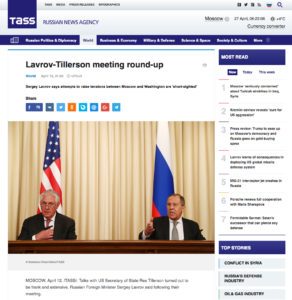 Key points from the Lavrov-Tillerson meeting with Putin in Moscow: When Moscow and Washington cooperate, the world benefits, Both nations are focused on an uncompromising war on terror.
Key points from the Lavrov-Tillerson meeting with Putin in Moscow: When Moscow and Washington cooperate, the world benefits, Both nations are focused on an uncompromising war on terror.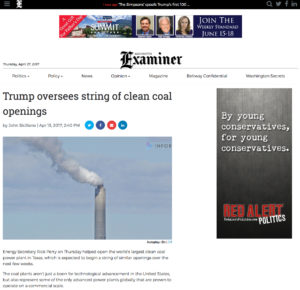 “While the Petra Nova project will certainly benefit Texas, it also demonstrates that clean coal technologies can have a meaningful and positive impact on the nation’s energy security and economic growth,” said Energy Secretary Rick Perry.
“While the Petra Nova project will certainly benefit Texas, it also demonstrates that clean coal technologies can have a meaningful and positive impact on the nation’s energy security and economic growth,” said Energy Secretary Rick Perry. 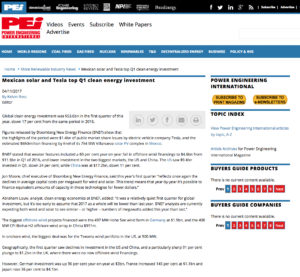 Global clean energy investment was $53.6 billion in the first quarter of 2017, down 17 per cent from the same period in 2016.
Global clean energy investment was $53.6 billion in the first quarter of 2017, down 17 per cent from the same period in 2016. 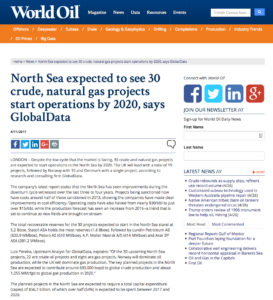 30 crude and natural gas projects are expected to start operations in the North Sea by 2020. The UK will lead with a total of 19 projects, followed by Norway with 10 and Denmark with a single project, according to GlobalData. The total recoverable reserves for these projects are expected to stand at 5.2 billion barrels of oil equivalent. The planned projects in the North Sea They are expected to require a total capital expenditure of $56.7 billion, of which over half (54%) is expected to be spent between 2017 and 2020.
30 crude and natural gas projects are expected to start operations in the North Sea by 2020. The UK will lead with a total of 19 projects, followed by Norway with 10 and Denmark with a single project, according to GlobalData. The total recoverable reserves for these projects are expected to stand at 5.2 billion barrels of oil equivalent. The planned projects in the North Sea They are expected to require a total capital expenditure of $56.7 billion, of which over half (54%) is expected to be spent between 2017 and 2020. The German company E.ON is investing in the development of airborne wind energy, which offers “game-changing technologies for renewable energy production”.
The German company E.ON is investing in the development of airborne wind energy, which offers “game-changing technologies for renewable energy production”. 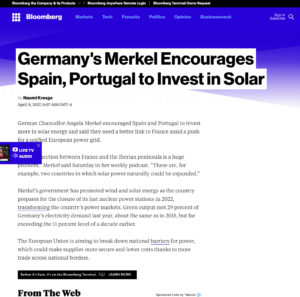 German Chancellor Angela Merkel encouraged Spain and Portugal to invest more in solar energy and said they need a better link to France amid a push for a unified European power grid.
German Chancellor Angela Merkel encouraged Spain and Portugal to invest more in solar energy and said they need a better link to France amid a push for a unified European power grid.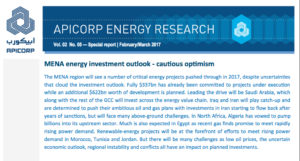 In the Middle East North Africa region $622 billion worth of development is planned in the energy sector for the next five years. The power sector accounts for the largest share at $207 billion, with the oil and gas sector at $195 billion and $159 billion respectively. Leading the drive will be Saudi Arabia, and Iraq and Iran will play catch-up. Algeria will pump billions into its upstream sector, and much is expected from Egypt’s recent gas. Renewable-energy projects will be at the forefront of efforts to meet rising power demand in Morocco, Tunisia and Jordan.
In the Middle East North Africa region $622 billion worth of development is planned in the energy sector for the next five years. The power sector accounts for the largest share at $207 billion, with the oil and gas sector at $195 billion and $159 billion respectively. Leading the drive will be Saudi Arabia, and Iraq and Iran will play catch-up. Algeria will pump billions into its upstream sector, and much is expected from Egypt’s recent gas. Renewable-energy projects will be at the forefront of efforts to meet rising power demand in Morocco, Tunisia and Jordan.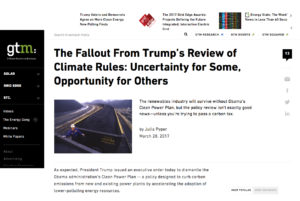 President Trump has issued an executive order to dismantle the Obama administration’s Clean Power Plan. The “Energy Independence” order lifts a moratorium on federal coal leasing, triggers a review of methane and hydraulic fracturing restrictions, and eliminates use of the Environmental Protection Agency’s “social cost of carbon” in policymaking. From a climate action perspective, there is widespread agreement that the order is bad news for U.S. emissions. Interestingly, 62 percent of Trump voters support taxing and/or regulating pollution causing global warming, and nearly three-quarters think the U.S. should use more renewable energy in future.
President Trump has issued an executive order to dismantle the Obama administration’s Clean Power Plan. The “Energy Independence” order lifts a moratorium on federal coal leasing, triggers a review of methane and hydraulic fracturing restrictions, and eliminates use of the Environmental Protection Agency’s “social cost of carbon” in policymaking. From a climate action perspective, there is widespread agreement that the order is bad news for U.S. emissions. Interestingly, 62 percent of Trump voters support taxing and/or regulating pollution causing global warming, and nearly three-quarters think the U.S. should use more renewable energy in future.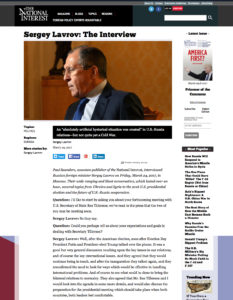 The interview covers various topics: Ukraine, Syria, U.S. presidential election, U.S.-Russia cooperation: “I don’t believe that we are having another Cold War.
The interview covers various topics: Ukraine, Syria, U.S. presidential election, U.S.-Russia cooperation: “I don’t believe that we are having another Cold War.